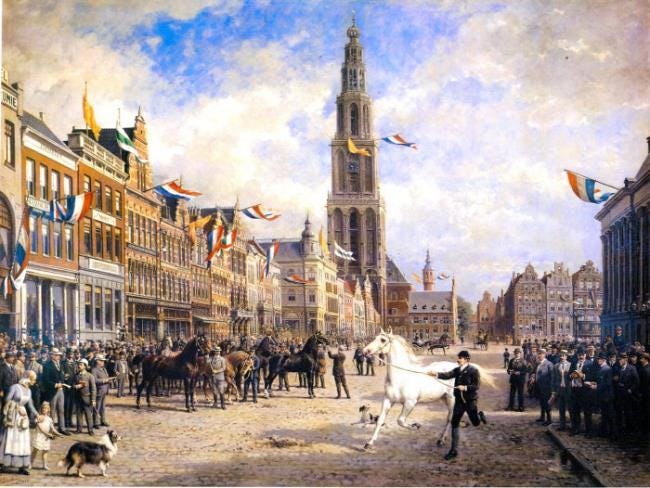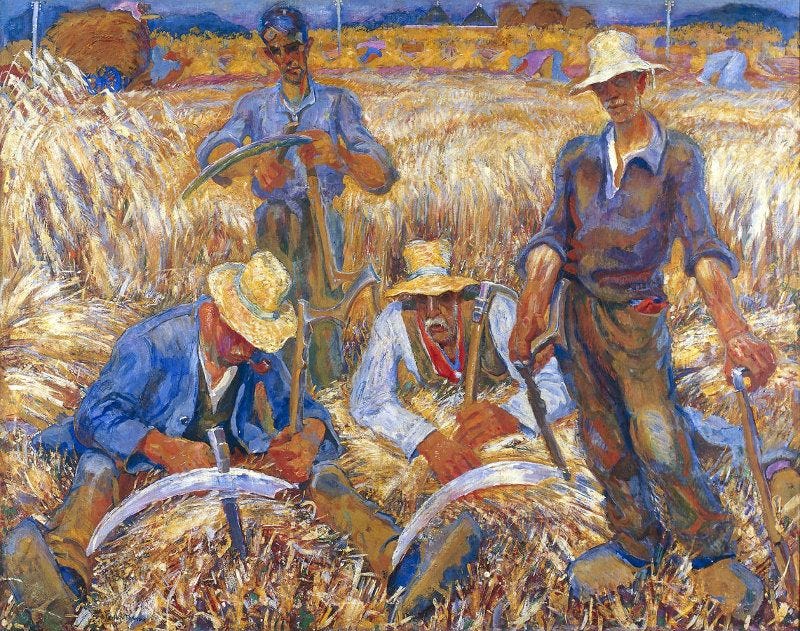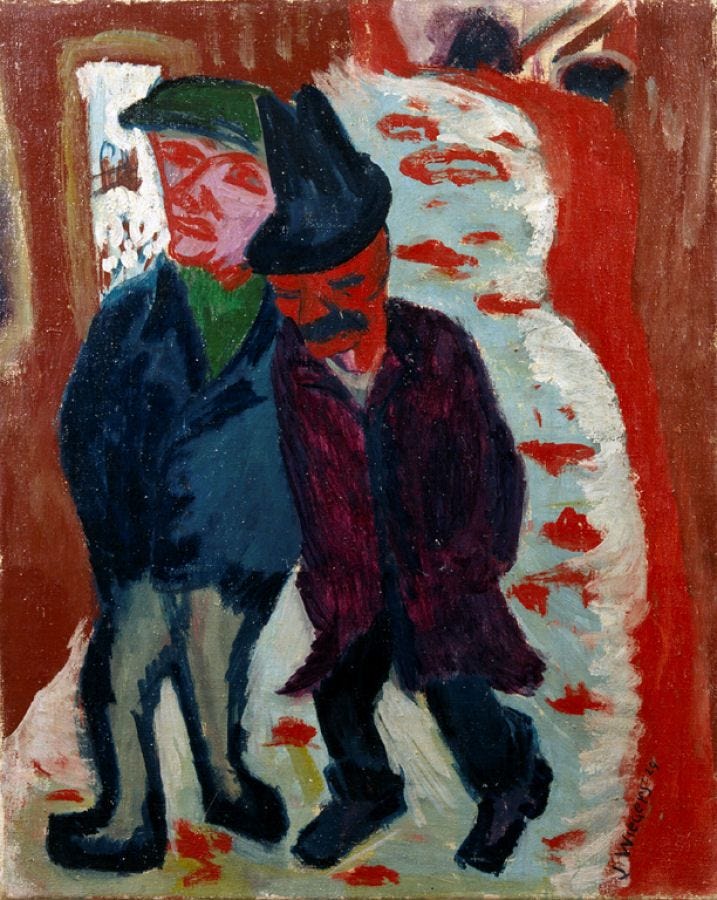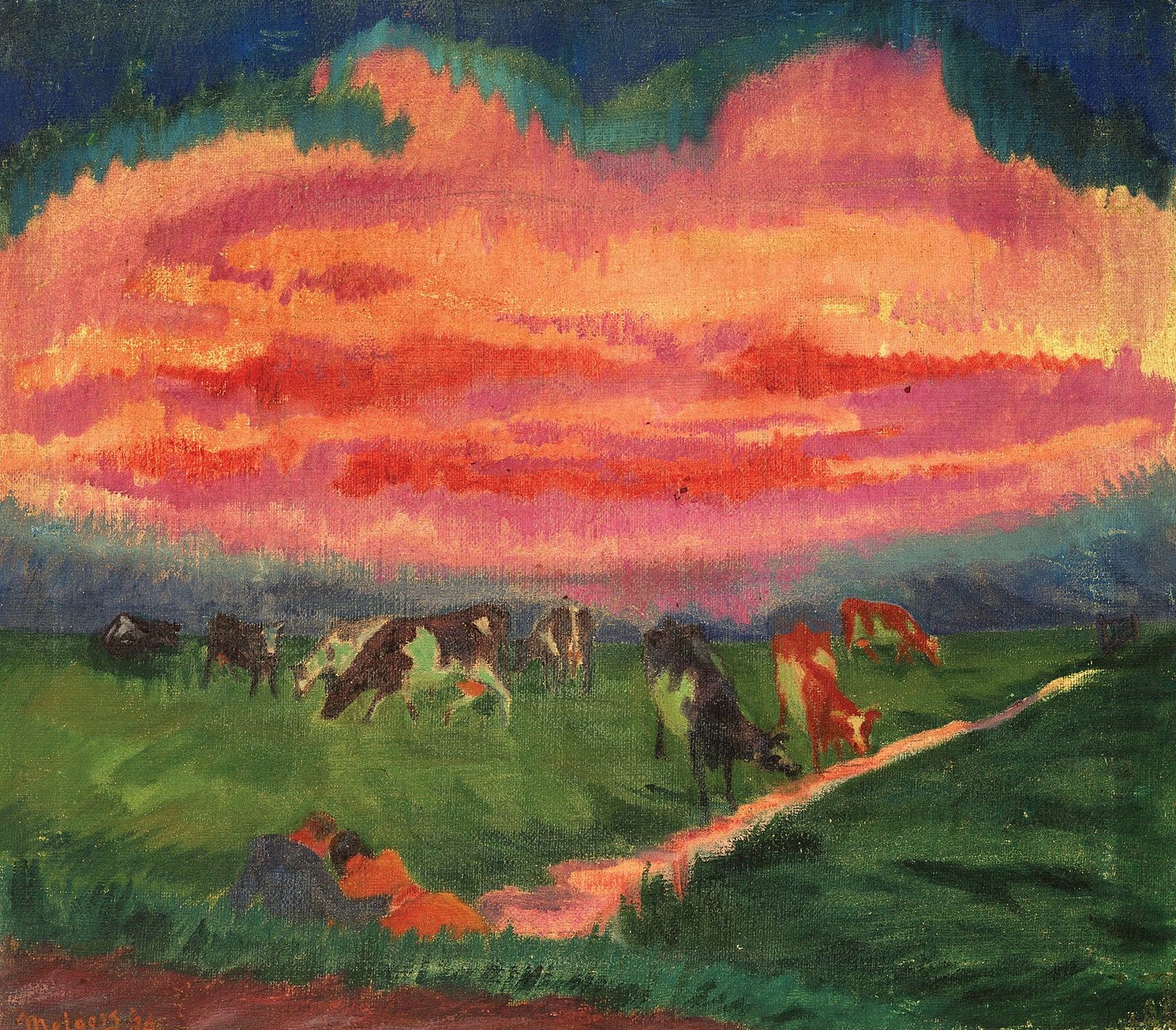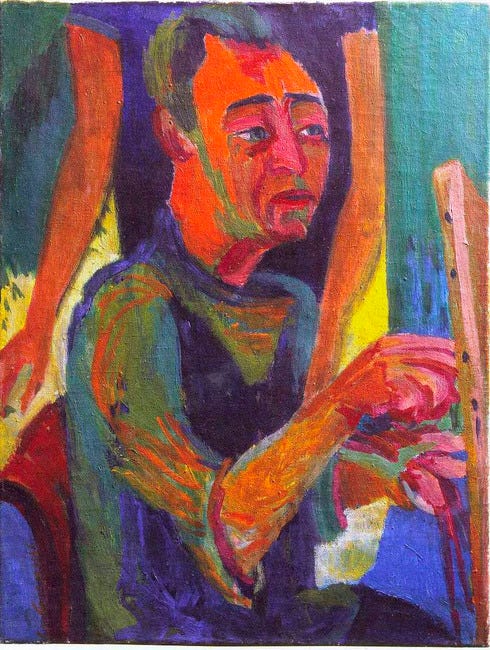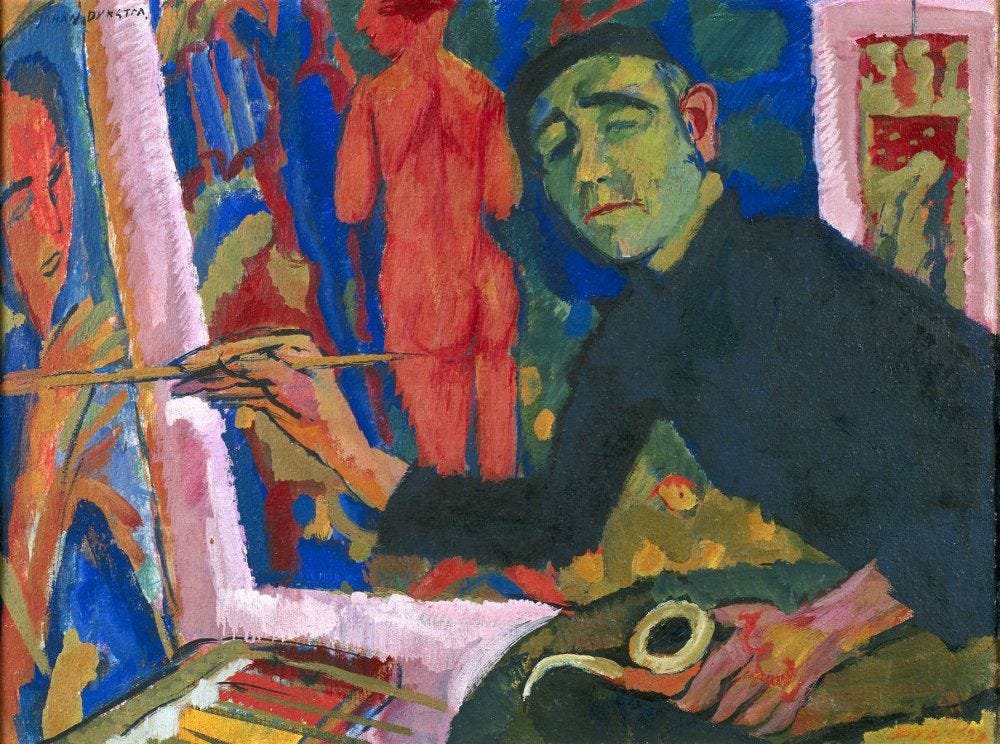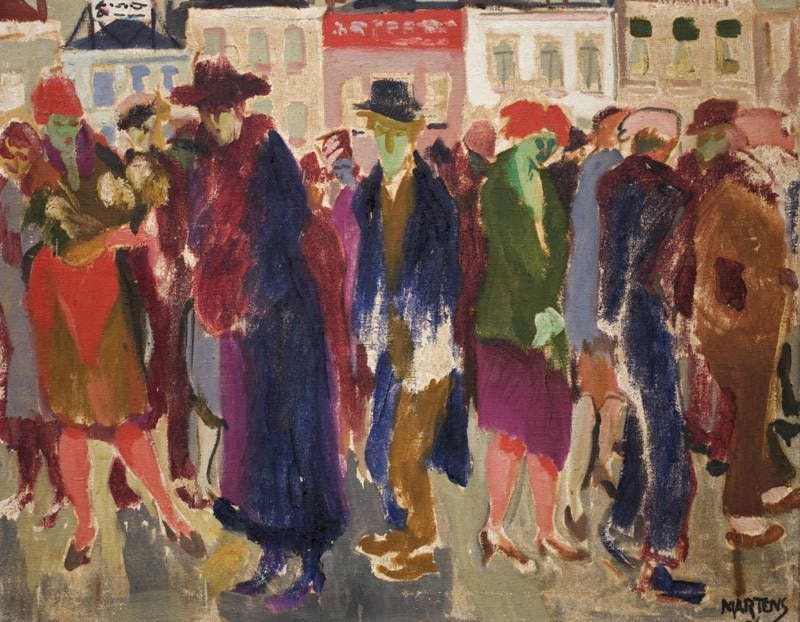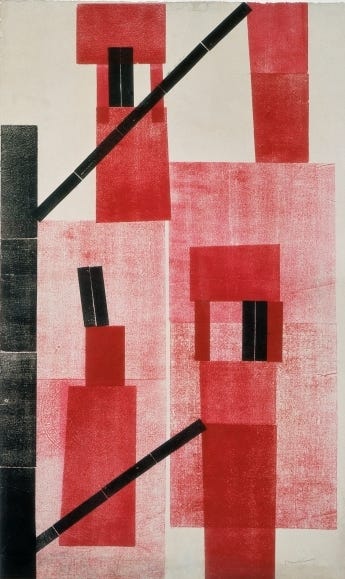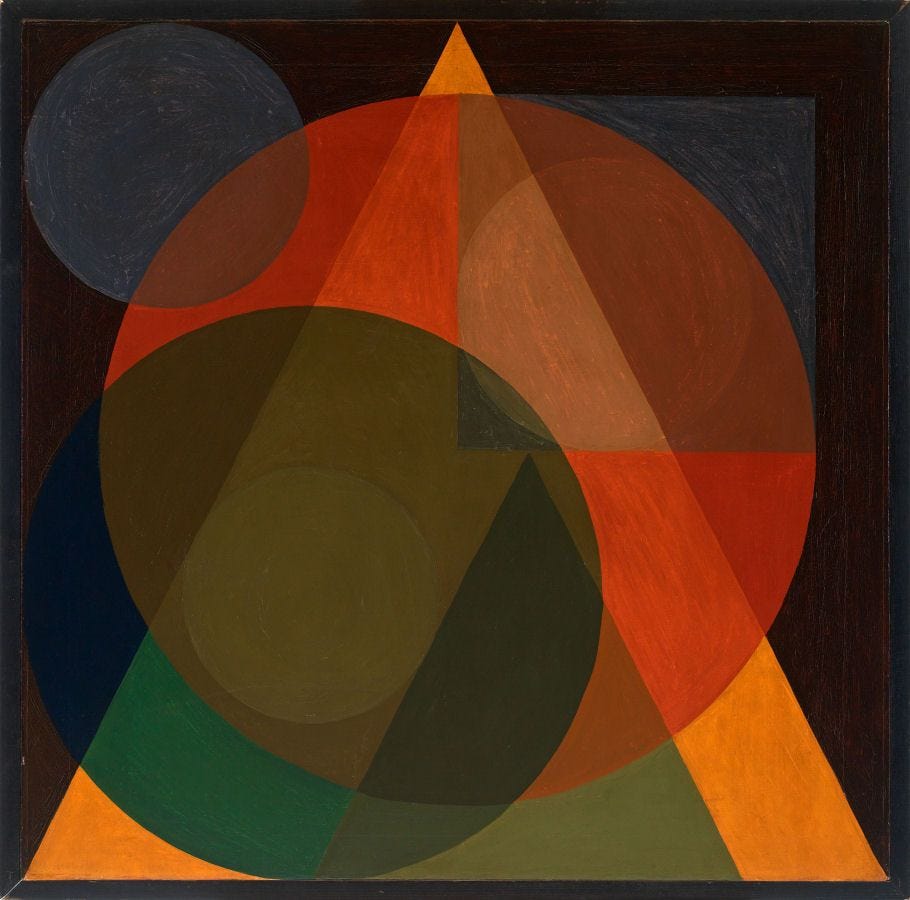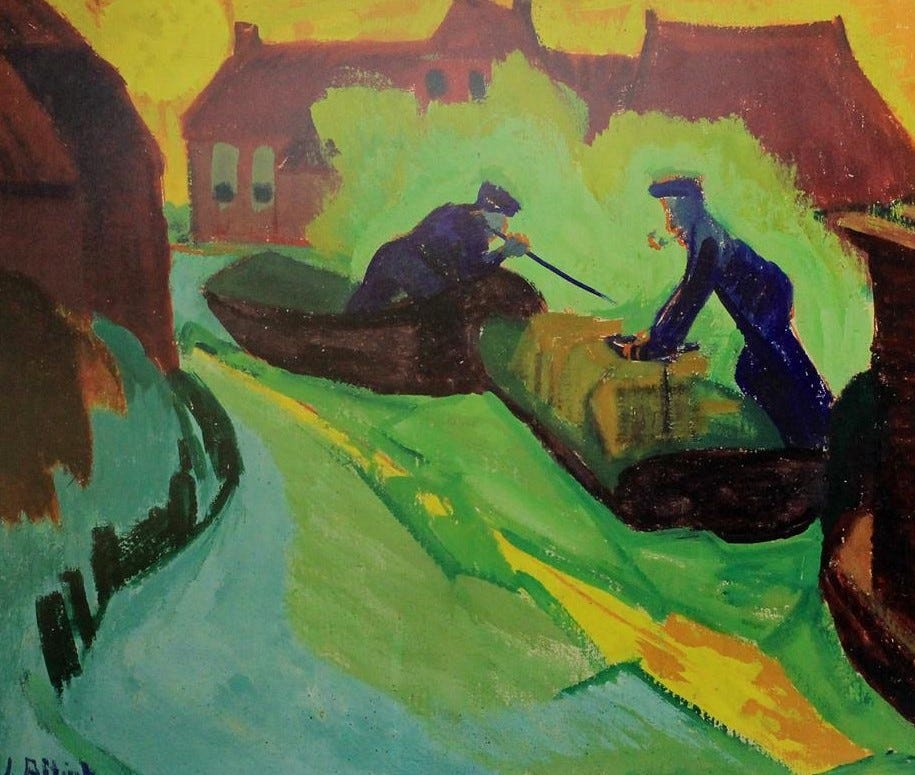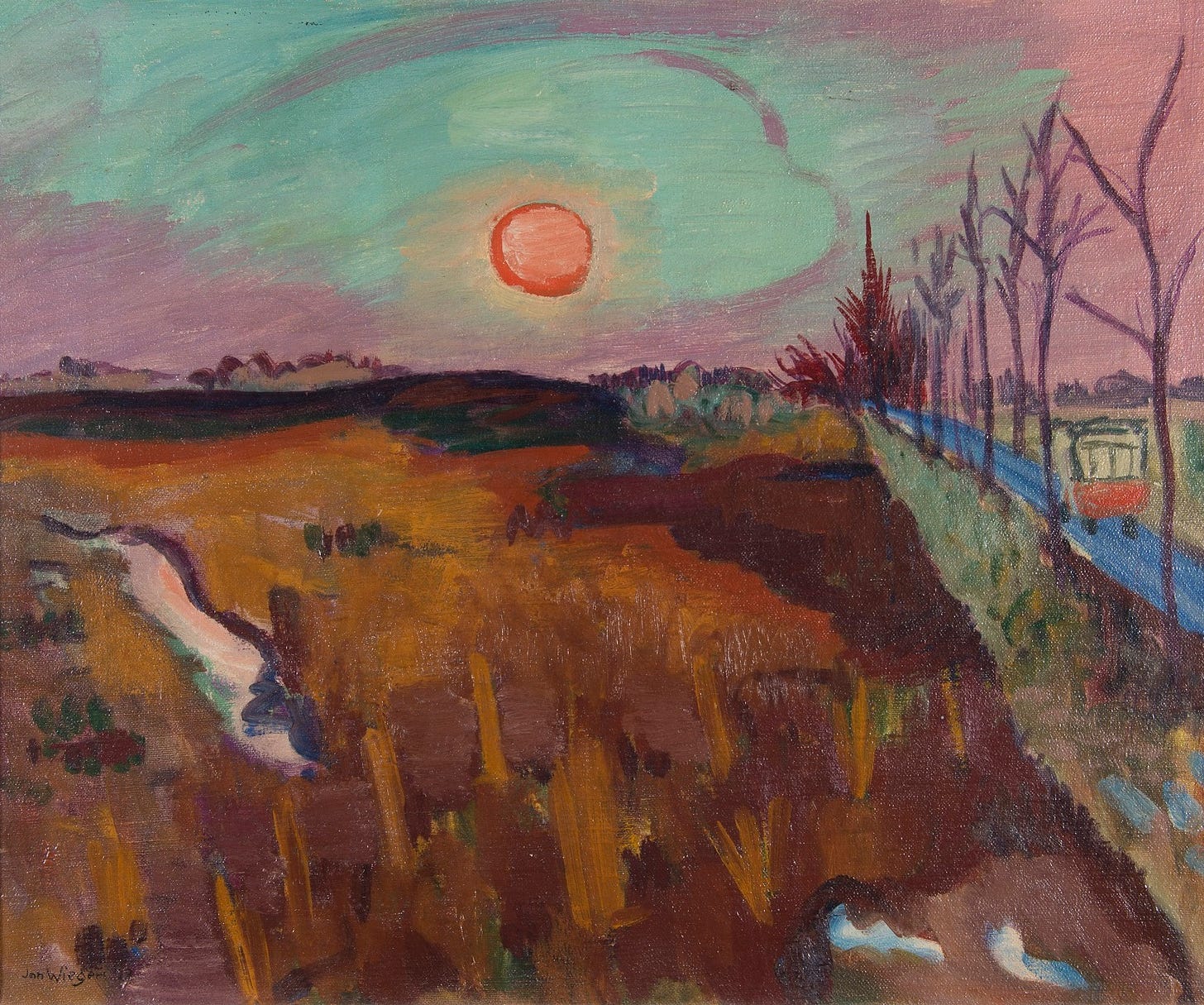In 1918 the Gallery Pictura held an exposition of artists from Groningen. The head of the jury in charge of choosing the paintings was Otto Eerelman, a famous artist known for his paintings of horses and dogs who had worked for the royal family. Under his watch, only paintings in traditional styles were accepted.
A group of young artists, interested in the European avant-garde, but feeling looked over by Gallery Pictura, met a few months later on May 31st at the Vogelzang (“Birdsong”) cafe. After a boisterous night of drinks and discussions they founded the artist collective De Ploeg.
The name “ploeg”—meaning “plough”—was suggested by Jan Altink: like the fields in the Groningen countryside that were being turned over and developed, so too was Groningen’s art world in need of cultivation. “We’ve waited too long for painters who didn’t always look the other way,” wrote Johan Dijkstra in 1922.
“Ploeg” also means team or crew or gang. The members of De Ploeg were friends as well as painters, urging on each others creative energies. The next ten years saw one of Groningen’s most flourishing periods of painting.
The traditional horse-inspection on 28th August in Groningen, Otto Eerelman (1920). Original title: De traditionele paardenkeuring op 28 augustus in Groningen.
The “Gronings Ontzet” happens every year in Groningen on August 28. It is a celebration of the end of the city’s siege in 1614 by Bernhard Galen, Bishop of Münster, also known as the bombing bishop. Traditionally, a horse show would be put on; this is the subject of Eerelman’s painting. The tall tower in the background is the Martinikerk in Groningen’s Grote Markt.
De Ploeg had no artistic manifesto. Members were not committed to a particular style, nor even to painting; some specialised in architecture, advertising, wood engraving, and printmaking; one, Daniel Ruyneman, was a composer; two others, Herman Poort and Hendrik de Vries, writers.
Several De Ploegers learned painting at the local Minerva Academy under F. H. Bach. He became a mentor to the group. They would all meet up north of the city at a hamlet called Blauwborgje where Bach taught them the fundamentals of painting en plein air, “in plain air.”
This way of painting in the outdoors—with little planning and changing light sources—encouraged quick, spontaneous works over precise compositions. Artists used quick, imprecise brush-strokes to impart a sense of movement and paid careful attention to light and colour.
Groningen’s countryside was a popular subject for De Ploeg. Their early paintings contain lots of landscapes, canals, animals in paddocks, and other scenes of rural life. The country road, symbolising travel, dynamism, and energy, was a common motif.
Reapers at Rest, Johan Dijkstra, 1924. (Original title: Rustende Zichters)
This painting is imposingly large, nearly 1.5 x 2 metres. The reapers, tired from working, cast their glances down in aloof postures. This is a scene of rural life ala Van Gogh, but while Van Gogh’s paintings pushed boundaries, they always clung to realism. Here the heat of day warps our perspective. The arms of the men are so long as to seem distorted. The one on the right has hands bigger than his head!
Johan Dijkstra won the 1925 Willink van Colleen competition for this painting. He saw it as closing out his early, rustic period. “Finally,” he wrote, “I can throw myself into the middle of the modern art movement.” What better way than by painting a literal ploeg—a crew or team—of workers?
The group was hard-up for cash, but the members of De Ploeg helped each other afford the materials necessary to paint. Canvases were often re-used, with old paintings sometimes covered-up and painted over.
In 1920 one of the members, Jan Wiegers, came down with tuberculosis. De Ploeg pitched in to send him to a sanitarium near Davos, Switzerland. There he befriended Ernst Ludwig Kirchner, a member of the German art group Die Brücke.
From Kirchner, Wiegers learned an expressionistic style of painting. Distinct, unnatural colours were selected to capture the emotional tone of a painting. Paints were diluted with a mixture of petrol and beeswax, giving the colours a dull, matte look. It also made the paint dry faster, making it harder to mix and blend, and leading to the use of more solid, contrasting blocks of colour. The features of people and places were simplified or caricatured, with sharp angles, deformed proportions, and distorted perspectives.
Two men in the snow, coming out of a cafe on the Boterdiep, Jan Wiegers, 1924. Original title: Twee mannen in de sneeuw, komend uit een cafe aan het Boterdiep.
A funny moment is captured here. Two men drunkenly stumble out of a cafe and through a street in the night, balancing on each other as they go. The wild colours and indistinct background suggest the kind of state they might be in. Compared with the Dijkstra painting, proportions and figures no longer seem realistic; legs twist at impossible angles while faces are geometrical in shape and unusually jolly in colour.
Landscape with lovers, Henk Melgers, 1926. Original title: Landschap met vrijend paartje.
Melgers chose a more harmonious range of colours here in comparison to the clanging, wacky contrasts of other De Ploeg paintings. Evening light (avondlicht) from the sunset is reflected in a canal, near to which the cows are grazing. Rough, thick brush-strokes capture the wind whipping through the grass in various directions. Because the horizon line is low in this painting, our eyes are naturally pulled up to the sky, so we share the same gaze as the lovers cuddling in the foreground.
With his stay in Switzerland at an end, Jan Wiegers brought expressionism back to Groningen. It had an immediate impression on his peers and quickly became the dominant style in De Ploeg.
Many in the group also became interested in painting the scenes of the city. Jan Wiegers did many paintings of Groningen’s roaring twenties, with its vibrant clubs and Bohemian cafes. George Martens painted increasingly abstract pictures of crowds in streets. They have a somewhat anxious, lonely feeling to them.
In 1926 Jan Wiegers and Johan Dijkstra challenged each other to a painterly duel. They made simultaneous portraits of each other in Wiegers’ atelier. This started a playful tradition of duel portraits between the members of De Ploeg, which are some of their most distinctive paintings.
Johan Dijkstra, by Jan Wiegers, 1926. Dijkstra seems rather careful and self-absorbed.
Jan Wiegers, by Johan Dijkstra. 1926. Wiegers sits in a funny little squat across the room from Dijkstra, smoking his pipe as he paints. To the left you can see the previous painting, the portrait of Dijkstra by Wiegers!
People in the Street - Vismarkt, George Martens. 1926.
Like the skinny buildings surrounding Groningen’s fish market (Vismarkt), some of which can be seen in the background, the people in this crowd are unnaturally tall and slender. Their faces are simple, almost childish. Half of them are turned towards us, as if disapproving, but the rest are too occupied with their own business.
After the death of Martens’ wife, Alida Pott—one of the founders of De Ploeg and its secretary for three years—Martens came back into a more traditional style.
While expressionism became the dominant style in De Ploeg, another faction moved in an even more abstract direction, under the influence of a style of painting called constructivism. Its members were H. N. Werkman, Jan van der Zee, and Wobbie Alkema. The trio rejected the kind of subjective experience that had come to the fore in expressionism, seeking instead a new objectivity through an artistic vocabulary of geometric shapes.
H. N. Werkman found out about constructivism from a 1922 exposition at the Gallery Pictura of a Dutch group called De Stijl. He became acquainted with De Ploeg because he printed their magazine Blad voor Kunst. A self-taught artist, he incorporated printing and typographic techniques into his works, such as the use of stencil plates and ink rollers.
Jan van der Zee learned to paint under F. H. Bach at the Minerva Academy. he knew Werkman from De Ploeg, and had started an advertising agency with Wobbie Alkema. He introduced them to each other, whereupon they immediately found a common artistic vision.
Alkema knew of constructivism through a Belgian magazine, Het Overzicht (“The Overview”). After reading a copy he cycled to Antwerp to meet the editors! Under Van der Zee’s encouragement, he joined De Ploeg at the end of 1924, but didn’t really fit in; Alkema didn’t drink and preferred his own company, plus the purity of his artistic vision was at odds with the overall direction of the group. He left within a year.
Chimneys 2, H. N. Werkman, 1923.
You can still discern objects and figures in the early works of the constructivists in De Ploeg. In Buddy Hermans’ documentary De Ploeg 1918-1928 it’s suggested that Werkman took inspiration for his paintings from the industrial area in which his print-shop was located, with its sloping brick buildings and the chimneys rising up out of them.
Compositie no. 3, Wobbe Alkema, 1924.
This painting was Alkema’s first to contain purely geometrical shapes. You cannot really discern any forms, objects, people, or places out of it.
De Ploeg never broke up. In fact, it still exists. But as different members went their own way, the creative burst of the 1920s slowly petered out, culminating in the jubilee exhibition in 1928.
While De Ploeg had no manifesto, the expressionism of Jan Wiegers became dominant. At De Ploeg’s 1924 exposition the committee, led by Siemon Steenmeijer and Job Hansen, only selected paintings with an expressionistic style—an ironic mirroring of what happened with Gallery Pictura in 1918.
Those members with a more traditional or abstract style were incensed and the group began to split from within. Two years later an even more “modernist” faction had taken over. Wobbe Alkema tried to rejoin, but his application was denied. The dominant style eventually drifted towards a more traditional one.
Reflecting on those years, Hendrik de Vries wrote: “The desperation and conceit of expressionism demands powers that are usually no longer present after a certain age.” In other words, everyone got old and things moved on.1
What strikes me about a lot of these paintings is how quickly they were done, often with little care to posterity. They were painted, and painted over, and painted on the back of. Duel portraits were made in a drunken evening, quick landscapes dashed off in an afternoon trip to Blauwborgje. Very often, our most spontanoues and careless actions are the ones with the most life in them.
The Icebreakers, Jan Altink, 1924. Original title: De ijsbrekers.
It looks like a very early morning for the two men that have to go out and break up the ice in Groningen’s waterways—the colours are muted, the sun perhaps not yet risen. Solid blocks of cool blues and greens make the water look frozen and immobile, except for the big splash where it has been freed.
Drenthe Winter Landscape, Jan Wiegers, 1928. Original title: Winterlandschap Drenthe.
Drenthe is a swampy region just south of Groningen. It has sandy ground that is not good for growing food. The cities are small and historically not many people lived there. The colours in this painting are somewhat murky, the swamp indistinct and messy, as if the place is not for human habitation. The sun boils out low in the sky as a purple night closes in.
Original quote: “De expressionistiche wanhoop of overmoed vergt krachten die gewoonlijk na zekeren leeftijd niet meer aanwezig zijn”. Quoted in Jikke van der Spek, De Schilders van de Ploeg, WBOOKS, Zwolle, 2016. p. 16. “Overmoed” is tough to translate; it means you have too much faith in your ability to do something, even when you’re not capable of it. I have translated this as “conceit”.




